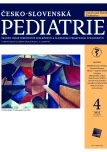Sepsis in children
Authors:
Fremuth Jiří; Šašek Lumír; Huml Michal; Kotková Alexandra; Forejt Jan; Sýkora Josef
Authors‘ workplace:
Dětská klinika, Lékařská fakulta a Fakultní nemocnice v Plzni, Univerzita Karlova v Praze
Published in:
Čes-slov Pediat 2022; 77 (4): 246-254.
Category:
Chapters for Specialization in Pediatrics
doi:
https://doi.org/10.55095/CSPediatrie2022/041
Overview
Despite advances in medicine, even in the 21st century, sepsis remains one of the main factors contributing to morbidity and mortality in childhood. The issue of sepsis in children has its own specifics. The aim of the article is to describe in a clear and comprehensive form the definition, etiology, epidemiology, pathophysiology, clinical picture, diagnosis and initial phase of treatment of sepsis outside the newborn age.
Keywords:
sepsis – children – pediatric – septic shock
Sources
1. Goldstein B, Giroir B, Randolph A, et al. International pediatric sepsis consensus conference: definitions for sepsis and organ dysfunction in pediatrics. Pediatr Crit Care Med 2005; 6(1): 2–8.
2. Schlapbach LJ, Javouhey E, Jansen NJG. Paediatric sepsis: old wine in new bottles? Intensive Care Med 2017; 43(11): 1686–1689.
3. Singer M, Deutschman CS, Seymour CW, et al. The Third International Consensus Definitions for Sepsis and Septic Shock (Sepsis-3). JAMA 2016; 315(8): 801–10.
4. Menon K, Schlapbach LJ, Akech S, et al. Pediatric sepsis definition-a systematic review protocol by the Pediatric Sepsis Definition Taskforce. Crit Care Explor 2020; 2(6): e0123.
5. Schlapbach LJ, Weiss SL, Bembea MM, et al. Scoring systems for organ dysfunction and multiple organ dysfunction: The PODIUM Consensus Conference. Pediatrics 2022; 149(1 Suppl 1): S23–S31.
6. Sehgal M, Ladd HJ, Totapally B. Trends in epidemiology and microbiology of severe sepsis and septic shock in children. Hosp Pediatr 2020; 10(12): 1021– 1030.
7. Cruz AT , Lane RD, Balamuth F, et al. Updates on pediatric sepsis. J Am Coll Emerg Physicians Open 2020; 1(5): 981–993.
8. Jarczak D, Kluge S, Nierhaus A. Sepsis-pathophysiology and therapeutic concepts. Front Med (Lausanne) 2021; 8:
9. Pierrakos C, Velissaris D, Bisdorff M, et al. Biomarkers of sepsis: time for a reappraisal. Crit Care 2020; 24(1): 287.
10. Oikonomakou M, Gkentzi D, Gogos C, et al. Biomarkers in pediatric sepsis: a review of recent literature. Biomark Med 2020; 14(10): 895–917.
11. Hernandez G, Bellomo R, Bakker J. The ten pitfalls of lactate clearance in sepsis. Intensive Care Med 2019; 45(1): 82–85.
12. Marikar D, Babu P, Fine-Goulden M. How to interpret lactate. Arch Dis Child Educ Pract Ed 2021; 106(3): 167–171.
13. Becker KL, Nylén ES, White JC, et al. Clinical review 167: Procalcitonin and the calcitonin gene family of peptides in inflammation, infection, and sepsis: a journey from calcitonin back to its precursors. J Clin Endocrinol Metab 2004; 89(4): 1512–25.
14. Downes KJ, Fitzgerald JC, Weiss SL. Utility of procalcitonin as a biomarker for sepsis in children. J Clin Microbiol 2020; 58(7): e01851–19.
15. Simon L, Saint-Louis P, Amre DK, et al. Procalcitonin and C-reactive protein as markers of bacterial infection in critically ill children at onset of systemic inflammatory response syndrome. Pediatr Crit Care Med 2008; 9(4): 407–13.
16. Weiss SL, Fitzgerald JC, Pappachan J, et al. Global epidemiology of pediatric severe sepsis: the sepsis prevalence, outcomes, and therapies study. Am J Respir Crit Care Med 2015; 191(10): 1147–57.
17. Boeddha NP, Schlapbach LJ, Driessen GJ, et al. Mortality and morbidity in community-acquired sepsis in European pediatric intensive care units: a prospective cohort study from the European Childhood Life-threatening Infectious Disease Study (EUCLIDS). Crit Care 2018; 22(1): 143.
18. Miller JM, Binnicker MJ, Campbell S, et al. A guide to utilization of the microbiology laboratory for diagnosis of infectious diseases: 2018 update by the Infectious Diseases Society of America and the American Society for Microbiology. Clin Infect Dis 2018; 67(6): e1–e94.
19. Davis AL, Carcillo JA, Aneja RK, et al. American College of Critical Care Medicine clinical practice parameters for hemodynamic support of pediatric and neonatal septic shock. Crit Care Med 2017; 45(6): 1061– 1093.
20. Weiss SL, Peters MJ, Alhazzani W, et al. Surviving sepsis campaign international guidelines for the management of septic shock and sepsis-associated organ dysfunction in children. Intensive Care Med 2020; 46(Suppl 1): 10– 67.
21. Weiss SL, Peters MJ, Alhazzani W, et al. Executive summary: surviving sepsis campaign international guidelines for the management of septic shock and sepsis-associated organ dysfunction in children. Intensive Care Med 2020; 46(Suppl 1): 1–9.
22. Bruns N, Dohna-Schwake C. Antibiotics in critically ill children-a narrative review on different aspects of a rational approach. Pediatr Res 2022; 91(2): 440–446.
23. Deep A, Goonasekera CD, Wang Y, et al. Evolution of haemodynamics and outcome of fluid-refractory septic shock in children. Intensive Care Med 2013; 39(9): 1602–9.
24. Rudd KE, Johnson SC, Agesa KM, et al. Global, regional, and national sepsis incidence and mortality, 1990-2017: analysis for the Global Burden of Disease Study. Lancet 2020; 395(10219): 200–211.
25. Zimmerman JJ, Banks R, Berg RA, et al. Trajectory of mortality and health- -related quality of life morbidity following community-acquired pediatric septic shock. Crit Care Med 2020; 48(3): 329–337.
26. Peshimam N, Nadel S. Sepsis in children: state-of-the-art treatment. Ther Adv Infect Dis 2021; 8: 20499361211055332.
Labels
Neonatology Paediatrics General practitioner for children and adolescentsArticle was published in
Czech-Slovak Pediatrics

2022 Issue 4
Most read in this issue
- Sepsis in children
- Differential diagnosis of microscopic hematuria
- Dystrophinopathies
- Hyperthermia, its causes and risks from the pathophysiologist’s perspective
